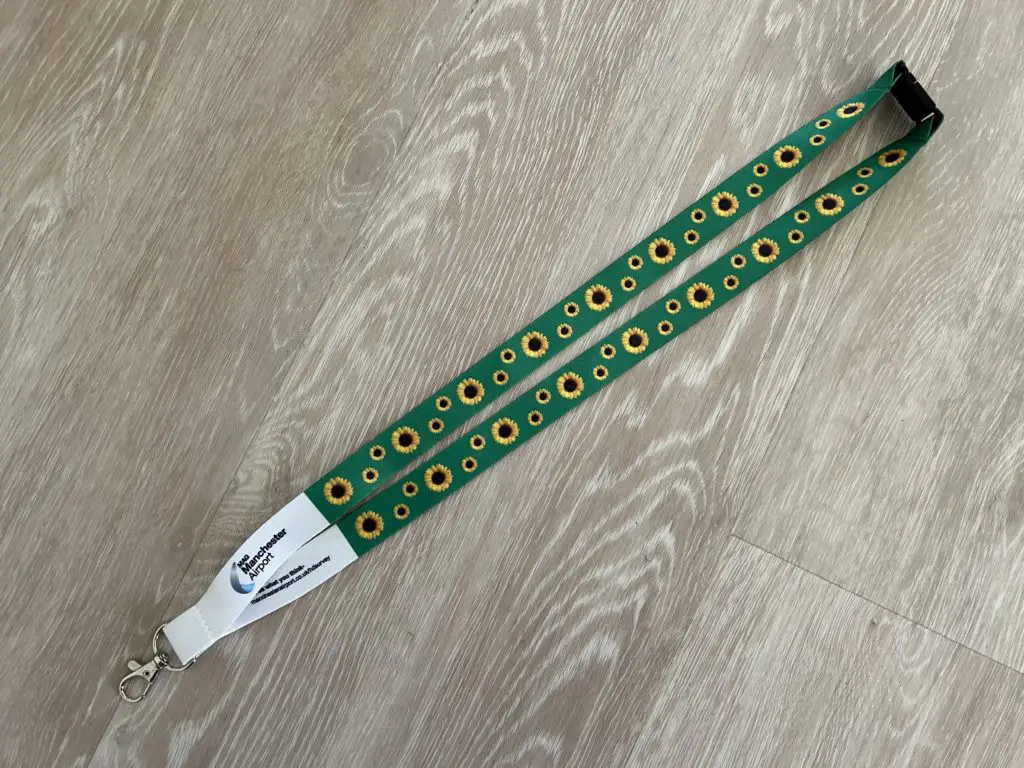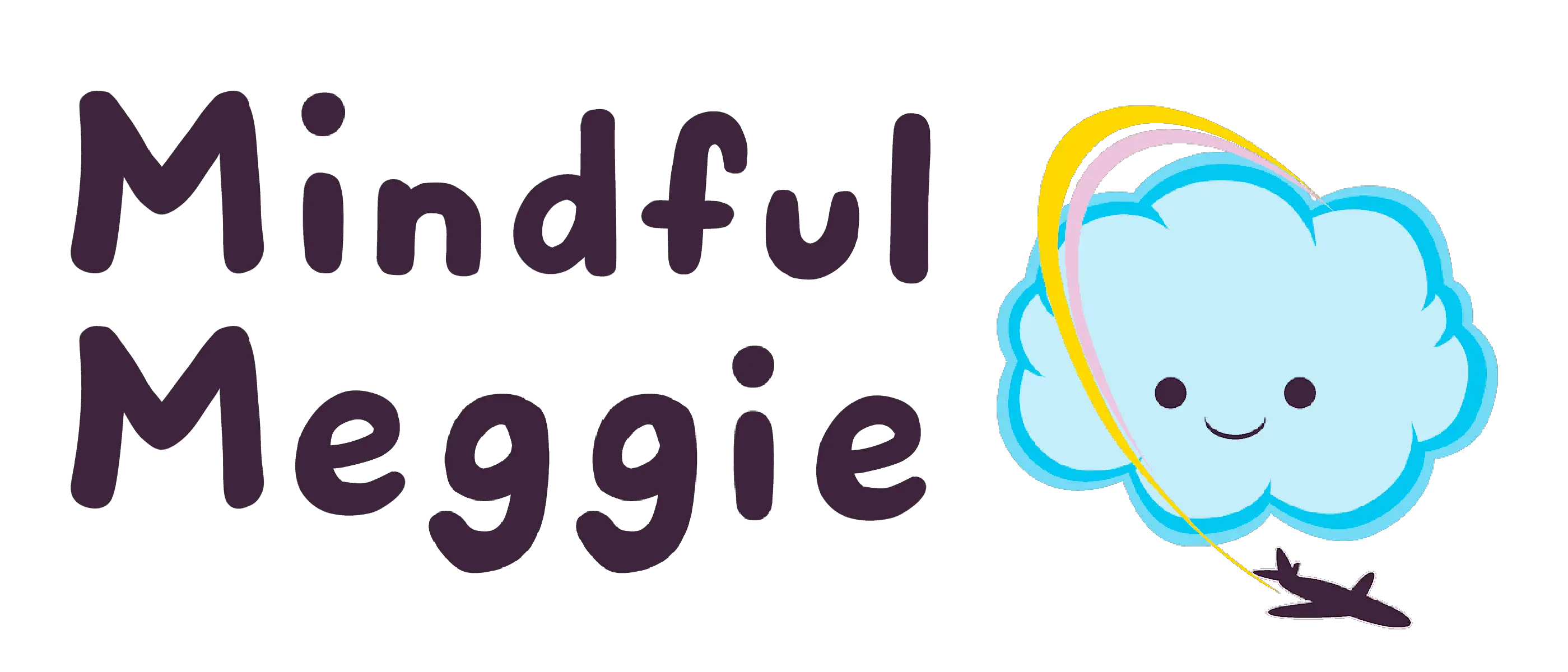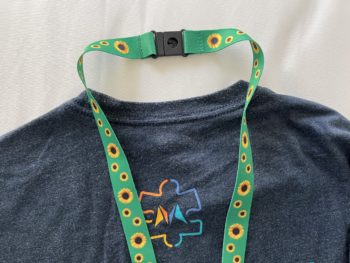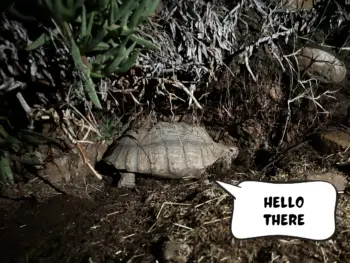
Posted: July 23, 2023
Have you seen people wearing a green lanyard with sunflowers? It may be a more common sight whether you’re at an airport, museum, supermarket, or sporting event. This cute lanyard is spreading worldwide! What could it mean?
I’ll tell you all about the Hidden Disabilities Sunflower Lanyard! I have traveled worldwide with this lanyard. I’ve also asked friends about their experiences with the lanyard. I’ve even spoken with several organizations.
People wear the Sunflower Lanyard to discreetly tell others that they have a hidden disability. That way, trained staff recognize that they have a disability and can help them.
Table of Contents
What is a hidden disability?
A hidden disability is any disability, physical or mental, where you cannot easily tell if someone has a disability. You wouldn’t know someone had diabetes unless they told you. Some people with hearing disabilities don’t have hearing aids.
Able-bodied people have disabilities too. I have a healthy physical body, but you wouldn’t think I had OCD, a mental condition, unless I mentioned it.
Disability is normal. According to stats from the Hidden Disabilities program, 1 in 6 people worldwide have a disability. 80% of those disabilities are hidden. That’s a whopping 1 billion people with a hidden disability. That makes the lanyard a valuable means of support!
How does the lanyard help people?
It might be hard for people with hidden disabilities to ask for help. It feels like others may not believe that they have a disability just because it’s invisible to the eye. People with hidden disabilities may feel invisible themselves!
The lanyard makes it easier to ask for help. When the wearer feels more acknowledged with their lanyard, they may be more comfortable and confident asking for help. At the very least, other people can offer more understanding, empathy, and patience.
In contrast, folks with visible disabilities could have an easier time asking for help. That’s because everyone can see that they’re disabled. My friend was traveling through airports with her elderly mother. When people saw the older woman in the wheelchair, it was obvious that she needed the airport staff to push her wheelchair to the plane.
Now what about my other friend doing airport travel? If you see her in public, you wouldn’t think she has autism, but she does. But if you recognize her Sunflower Lanyard, you’ll know she has a hidden disability of some sort. (She even chose to attach a personalized “autism” card to her lanyard to notify others.) She and her father asked to sit together on the plane, and the flight crew made those accommodations.
Learn how the lanyard can help autistic people.
Who can get the lanyard?
Anyone can as long as they have any hidden disability. The Sunflower program uses the trust system. You don’t need to prove your disability, so there aren’t any sign-up forms asking for your disability information.
Is the lanyard required?
No, no one is required to wear the lanyard. It’s purely optional. Some folks with hidden disabilities may choose not to wear it.
Those with the lanyard can wear it whenever they want. Maybe they’ll wear it in everyday life or just in select public places. (I personally wear it only at airports where I feel my OCD is a stressor sometimes.)
The lanyard alone doesn’t tell others which disability the person has, so the disability is kept anonymous. However, some people may choose to disclose the disability by attaching a card with a label. They might even get it personalized. They may do this to avoid any awkwardness in talking about it to others. For example, my friend attached a personalized “autism” card with her picture, an emergency contact, and a short explainer of her condition.
Learn how the lanyard can help autistic people.
When did the lanyard program begin?
London Gatwick Airport wanted to help its travelers with hidden disabilities. So in 2016, the airport was the first place in the world to recognize the Sunflower Lanyard. It spread throughout the United Kingdom and eventually the world!
Why the sunflower?
Its yellow color is easy to see. Plus, the sunflower is a cheerful flower that symbolizes confidence and positivity.
Is the lanyard recognized everywhere?
It isn’t recognized everywhere. Not everyone knows about it. That being said, it’s becoming more commonplace worldwide.
Some institutions don’t agree with the Sunflower Lanyard. Many American airports recognize the lanyard, but not my local airport, Los Angeles International. When I emailed their disability office about it, I got a response from Tim Ihle, a manager at LAX, saying that the lanyard backfires because a hidden disability should be everyday knowledge, not a discreet message.
My former local airport, Phoenix Sky Harbor International, doesn’t participate in the Sunflower program. Instead, they run their own program, the Compassion Cacti. It gives out a different lanyard with the same green background, just with cacti instead of sunflowers.
I had an interview with Leonardo Flores, who works at the Compassion Corner office at Sky Harbor. Flores said, “We need to be more compassionate to people, you know? At Sky Harbor, we’ve made our own program inspired by the original Sunflower program. It can only be used at Sky Harbor.”
I don’t travel through Sky Harbor these days. That’s why my Cacti Lanyard has been sitting in my storage box ever since I picked it up!
Even if the Sunflower Lanyard isn’t recognized everywhere, it can still be worn wherever and whenever.
Where is the lanyard most recognized?
During my travels, the lanyard is most commonplace in the United Kingdom. Considering the lanyard began at London Gatwick Airport, it makes sense. In the UK, it is recognized at airports, major supermarkets, public trains, and shopping centers. I’ve seen the lanyard in everyday life. Even the time I visited a museum in England, I saw a volunteer wearing it! We had the lanyard in common, so it was easy for me to start a casual chat with her.
In the United States, the lanyard is most recognized at airports big and small, from San Jose to Denver to Tulsa to Atlanta. Outside of the airport, I haven’t found the lanyard common in everyday American life. However, more institutions like Visit Ogden (Utah) and Visit Mesa (Arizona) are participating in the program.
For more information about getting the lanyard for free at airports, visit my complete airport guide.
Brazil has gone big time with it. Their national government recently signed the Sunflower into law, mandating that the Sunflower symbol is recognized countrywide! They even broadcast the Sunflower onto Rio de Janeiro’s Christ the Redeemer statue.

Where else is the lanyard recognized?
The lanyard is recognized across 5 continents. It’s common to use it at an airport. Otherwise, it may be found in other public places using this map.
Each year, more and more organizations, governments, and public places are training their staff to recognize the lanyard.
It’s even getting recognized at events! The lanyard has hit international sporting events, like the 2023 FIFA World Cup in Australia and New Zealand. It’s also happening on the local level with, for example, games of the Brentford Football Club in England.
As far as I know, Party Parrot World is the first online game to have the Sunflower Lanyard. I got permission from Lynn Smith, the director of the North American Sunflower program, to have the lanyard in the game. As a producer of this game (my username is Tech70), I want to allow players to collect the lanyard and wear it on their parrot avatar.

***
The Sunflower Lanyard fosters understanding and support for folks with hidden disabilities. With more and more businesses adopting the program each year, the lanyard is spreading worldwide. People with a hidden disability can choose to wear the lanyard if they’d like to. We deserve a more inclusive, accessible world for hidden disabilities. And this lanyard is making that happen!
Here are more lanyard resources to help you on your journey:
Sources
Airports around the world. Hidden Disabilities Sunflower Scheme Limited, n.d., https://hdsunflower.com/us/insights/post/airports-around-the-world. Accessed 18 July 2023.
Brentford FC are Hidden Disabilities Sunflower members! Hidden Disabilities Sunflower Scheme Limited, n.d., https://hdsunflower.com/us/insights/post/brentford-fc-are-hidden-disabilities-sunflower-members. Accessed 23 July 2023.
FIFA Women’s World Cup 2023™. Hidden Disabilities Sunflower Scheme Limited, n.d., https://hdsunflower.com/us/insights/post/fifa-womens-world-cup-2023. Accessed 22 July 2023.
Hidden Disabilities Sunflower and Christ the Redeemer: Representing diversity. Hidden Disabilities Sunflower Scheme Limited, n.d., https://hdsunflower.com/us/insights/post/cristo-redentor. Accessed 23 July 2023.
Our history, Hidden Disabilities Sunflower Scheme Limited, n.d., https://hdsunflower.com/us/insights/post/history. Accessed 23 July 2023.
Visit Mesa Hidden Disabilities Sunflower Program. Visit Mesa, n.d., https://www.visitmesa.com/travel-accessibility/hidden-disabilities-sunflower-program/. Accessed 22 July 2023.
Visit Ogden joins the Hidden Disabilities Sunflower. Hidden Disabilities Sunflower Scheme Limited, n.d., https://hdsunflower.com/us/insights/post/Visit-Ogden-joins-the-Hidden-Disabilities-Sunflower. Accessed 23 July 2023.
What is a hidden disability? Hidden Disabilities Sunflower Scheme Limited, n.d., https://hdsunflower.com/us/insights/category/invisible-disabilities. Accessed 23 July 2023.
What is the Hidden Disabilities Sunflower? Hidden Disabilities Sunflower Scheme Limited, n.d., https://hdsunflower.com/us/insights/post/for-people-with-non-visible-disabilities. Accessed 18 July 2023.
(Image credit: Christ the Redeemer from the Hidden Disabilities Sunflower Scheme).



 How Autistic People Can Get Support with the Hidden Disabilities Sunflower Lanyard
How Autistic People Can Get Support with the Hidden Disabilities Sunflower Lanyard